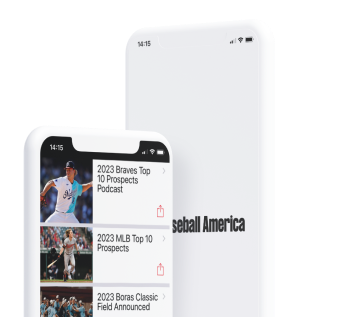2024 Top MLB Draft Prospects


The BA 500 is an attempt to capture the industry’s consensus on the talent of the 2021 draft class—not to predict where players will be selected. The list was compiled in consultation with major league scouts, front office executives, scouting directors, college coaches and other professional evaluators. Ben Badler, Alexis Brudnicki, Teddy Cahill, JJ Cooper, Kyle Glaser, Joe Healy, Bill Mitchell, Chris Trenkle and Carlos Collazo contributed to the reporting and writing. Mark Chiarelli, Josh Norris and Chris Trenkle contributed to editing.
By Carlos Collazo
Well, it’s finally here—the 2021 BA 500!
No, we’re not late, but this is the deepest into the calendar year we have ever released the BA 500, as the 2021 draft is the first to be moved into July and tied to the MLB All-Star Break.
Baseball has largely put Covid-19 behind it this spring, but the 2021 draft class has still felt the ripple effects of the pandemic. While it won’t be remembered as the Covid draft in the same way the five-round 2020 draft last year will be, there’s an argument to be made that the 2021 draft class is equally impacted by the virus—if not more so.
Scouts wondered if that would be the case a year ago, as Covid largely blew up the summer evaluation period for scouts and players alike, especially amongst the college ranks. No Collegiate National Team. No Cape Cod League. No 18U National Team. While many high school events took place in the South, players from the West Coast were more limited in their options and scouts themselves had to miss events entirely due to personnel restrictions (and in some cases layoffs) and further step into the world of video scouting by writing reports remotely.
That dynamic has led to plenty of volatility during the season as players who previously didn’t have a chance to establish a track record or baseline of performance stood out, and others with some history struggled. Teams are now left to try and sort out the signal from the noise by more heavily relying on area scouts and their history and/or adjusting their models to incorporate a much smaller sample of college stats.
Those factors—on top of the exceptional depth of the 2021 class thanks to the five-round draft last year that brought back many players who would have been drafted in a typical year—have led to less consensus on the class than ever.
“This year I have no expectations because it is so wide open,” said one scouting director. “When I walk into that draft room the night of the draft I wouldn’t be surprised if it was completely all over the place in terms of where guys go. Just not a lot of consensus.”
There’s not a consensus No. 1 player in the class and instead a group of five players are generally seen as the top tier of talent. That group includes toolsy prep shortstops Jordan Lawlar and Marcelo Mayer, renowned Vanderbilt righthanders Jack Leiter and Kumar Rocker and Louisville catcher Henry Davis, who was one of the best performers of the season.
After a full spring, the high school class looks more impressive than the college group. The 2021 class has a chance to be one of the best prep shortstop classes we’ve ever seen, with four potential top-10 picks at the position and a slew of intriguing depth options as well. Outside of the shortstops there is a bounty of up-the-middle position players with unusually impressive athleticism and tools.
The high school pitching group, led by righthanders Jackson Jobe and Andrew Painter, seems close to average, with several legitimate first-round talents and perhaps more lefthanded pitching depth than in an average class.
Scouting departments were worried about the college hitting class entering the year, but there was hope that throughout the spring players would step forward and make it at least average. That doesn’t appear to have been the case. Most evaluators see the college hitters as the weakest demographic of the group—with a notable absence of shortstops and corner profiles with power—and it’s a solidly below-average college hitting class overall.
The college pitching saw attrition during the season as potential top-10 players like Gunnar Hoglund and Jaden Hill suffered season-ending injuries, but the group seems solid or a tick above-average on talent—but significantly below-average in terms of innings and established track record.
Overall, the 2021 class seems weaker than teams would prefer at the very top, but with elite depth that might leave organizations more excited with their draftees on Days Two and Three than in a typical year.
We will continue to make tweaks and adjust the BA 500 as necessary as we get closer to draft day.
*BA Grades and Tool Grades — We’re excited to roll out BA Grades and tool grades for the top 200 players in the class for the first time. BA readers familiar with the Prospect Handbook should be familiar with these grades, which are based on the 20-80 scouting scale. Our attempt is to provide a deeper understanding of the class in a quantifiable manner and to also make it easier for readers to have a rough estimate of where a player might rank within a team’s Top 30 once they are drafted. Please note that all player grades and tool grades are future grades, not present grades.
**Rapscores — 85% of Baseball America’s Top 500 MLB prospects use Rapsodo data for player development and evaluation. In collaboration with Driveline Baseball, Rapsodo developed RapScore as a standard scale for scouting and recruiting. Utilizing the principles of the 20-80 scale and the verified data collected by Rapsodo’s technology, RapScore provides a quantifiable way to compare athletes of all ages. Players that complete a Rapsodo Certified Assessment receive a RapScore and are listed on the Rapsodo National Player Database.

Comments are closed.